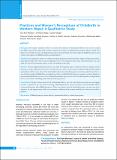Please use this identifier to cite or link to this item:
https://hdl.handle.net/20.500.14356/1198Full metadata record
| DC Field | Value | Language |
|---|---|---|
| dc.contributor.author | Bhandari, Tulsi Ram | - |
| dc.contributor.author | Wagle, Shreejana | - |
| dc.contributor.author | Dangal, Ganesh | - |
| dc.date.accessioned | 2023-05-02T09:28:13Z | - |
| dc.date.available | 2023-05-02T09:28:13Z | - |
| dc.date.issued | 2020 | - |
| dc.identifier.citation | BhandariT. R., WagleS., & DangalG. (2020). Practices and Women’s Perceptions of Childbirth in Western Nepal: A Qualitative Study. Journal of Nepal Health Research Council, 18(1), 64-69. https://doi.org/10.33314/jnhrc.v18i1.2413 | en_US |
| dc.identifier.issn | JNHRC Print ISSN: 1727-5482; Online ISSN: 1999-6217 | - |
| dc.identifier.uri | http://103.69.126.140:8080/handle/20.500.14356/1198 | - |
| dc.description | Original Article | en_US |
| dc.description.abstract | Abstract Background: Despite continuous efforts to increase the utilization of institutional delivery care services nearly two-fifths women deliver their babies at home without the assistance of skilled birth attendants (SBA) in Nepal. The skilled care at birth can reduce the high maternal and neonatal mortality. This study explored childbirth practices and women’s perceptions of childbirth and its associated factors. Methods: An exploratory study was conducted in three purposively selected remote villages of Kapilvastu district, from March to May 2017. Face-to-face in-depth interviews were conducted with women who had an under-one year child. We performed a thematic analysis to draw the findings of the study. Results: Women sought institutional delivery care either for long labor-pain or obstructed-delivery. Despite various incentives, people still preferred home for normal deliveries. There was also practiced skilled birth attendant (SBA) assisted home delivery care. Some of the local health workers also advised pregnant-women for assisted home delivery care. People considered childbirth as a normal process. Due to cultural beliefs and norms, people were also reluctant to pursue institutional delivery care services. Financial constraints, poor access to services and expensive transportation services were other underlining causes of home delivery practices. Conclusions: Despite various incentives for institutional delivery care; the study did not spectacle an encouraging reaction. It pointed to the very basic and strong relationship between women’s position in the household and the society and education with childbirth practices. There were limits to how far financial incentives can overcome these obstacles. So, the improvement of the socio-economic conditions of the women would be the viable way-out of the problem. Keywords: Childbirth practices; home delivery; institutional delivery; women’s perception | en_US |
| dc.language.iso | en | en_US |
| dc.publisher | Nepal Health Research Council | en_US |
| dc.subject | Childbirth practices | en_US |
| dc.subject | Home delivery | en_US |
| dc.subject | Institutional delivery | en_US |
| dc.subject | Women’s perception | en_US |
| dc.title | Practices and Women’s Perceptions of Childbirth in Western Nepal: A Qualitative Study | en_US |
| dc.type | Journal Article | en_US |
| local.journal.category | Original Article | - |
| Appears in Collections: | Vol. 18 No. 1 (2020): Vol. 18 No. 1 Issue 46 Jan-Mar 2020 | |
Files in This Item:
| File | Description | Size | Format | |
|---|---|---|---|---|
| 2413-Manuscript-14308-1-10-20200420.pdf | Fulltext Artocle. | 318.91 kB | Adobe PDF |  View/Open |
Items in DSpace are protected by copyright, with all rights reserved, unless otherwise indicated.
